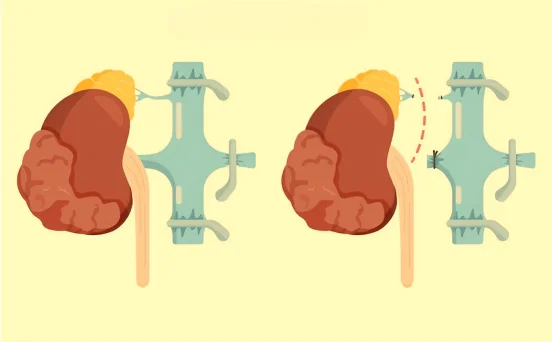Pyeloplasty is a type of surgical operation carried out to treat ureteropelvic junction (UPJ) obstruction. This obstruction occurs at the interface of the ureter which transports urine to the bladder, and the renal pelvis. It may lead to an increase in pressure within the kidney (hydronephrosis), infection, and gradual diminution in kidney function.
Pyeloplasty surgery is best suited for remedial treatment for pyeloplasty surgery. It is usually done by laparoscopic or robot-assisted techniques which are less invasive.
What Is The Rationale For Pyeloplasty Surgery?
An UPJ obstruction may be congenital or acquired through kidney stones or infections. If this condition is allowed to progress without intervention, the following may be observed:
- Damage to the kidney
- Chronic UTI complaints
- Flank Pain
- Reduced kidney function
Restorative interventions are essential to enable normal urine flow, remove obstructive and compressive symptoms, alleviate risks of kidney damage, and promote kidney health.
Symptoms That Indicate You May Need Pyeloplasty
Understanding of the treatment for pyeloplasty surgery
Based on your symptoms, your physician may initiate an examination for UPJ obstruction:
- Side or abdominal discomfort (particularly post fluid intake)
- Recurring urinary tract infections
- Hematuria (blood present in urine)
- Nausea or vomiting
- Fever and chills (infections)
- Congenital poor growth in children
- Kidneys swelling which can be detected in ultrasound
Diagnosis Before Pyeloplasty Surgery
Prior to the treatment of pyeloplasty surgery the physician will conduct various diagnostic tests which confirm existence and severity of obstruction:
Ultrasound Imaging
This is non-invasive and often the first test performed which aids in the detection of kidney swelling.
CT Urogram / MRI Urogram
Ultrasound was not sufficient; it gives precise depiction of urinary tract and possible blockages.
Diuretic Renal Scan (MAG3)
This helps assess the functions of the kidneys in draining efficiently.
Voiding Cystourethrogram (VCUG)
This is sometimes done for children in assessing for urinary reflux.
Treatment Options for Pyeloplasty Surgery
For UPJ obstruction treatment is predominantly surgical. Different methods include:
Open Pyeloplasty
- Standard method which involves abdominal incision.
- Has a high success rate (greater than 90 percent).
- Results in a longer recovery period.
Laparoscopic Pyeloplasty
- This method is minimally invasive which involves small incisions.
- Results in reduced pain and faster recovery.
- Frequently recommended for grown-ups.
Robotic-Assisted Pyeloplasty
Uses precision robotic arms for high accuracy.
Often done in children and in more complicated cases.
Less healing time and scarring.
Endopyelotomy (Less Common)
- Uses a scope to attempt to cut the obstruction.
- Lesser success rate than laparoscopic or robotic counterparts.
- Mostly seen in selective cases among grown patients.
The Surgical Procedure: What To Expect
- Preoperative Imaging And Blood Work.
- Fasting the night before is required.
- General anesthesia is provided.
- During surgery, the obstructed portion of the ureter is removed.
- The ends are reconnected (anastomosis).
- A stent might be placed for healing support.
- Time: 2-3 hours depending on method.
Recovery After Pyeloplasty Surgery Recovery Variation places difference in approach, whether open or minimally invasive.
Length of Hospital Stay
- 1–3 days (upon completion of laparoscopic/robotic procedures)
- Up to 5–7 days (for open surgery)
At Home
- Light activity may be resumed in 7–10 days
- Stent removal in 4–6 weeks
- Complete recovery in 4–6 weeks
Monitoring
- Ultrasound will be performed or a renal scan conducted to evaluate drainage.
- Kidney function will be regularly monitored in follow-up appointments.
The surgery has a greater than 95% success rate for both adults and children when carried out by a trained urologist. Most individuals achieve symptom relief and better renal function.
Risks and Complications
While uncommon, these issues can arise:
- Leakage of urine
- Infection
- Blood loss
- The formation of cysts or other scars that may obstruct
These conditions are associated with minimal risk and can be easily remedied with appropriate treatment.
Pyeloplasty in Children
In infants and small children, the congenital UPJ obstruction is frequently encountered. Pediatric pyeloplasty is usually considered necessary when:
- There is severe hydronephrosis.
- There is renal insufficient.
- Infections are recurring.
Robotic or laparoscopic approaches are preferred because of the quicker recovery period and less scarring.
Conclusion
Surgical treatment for pyeloplasty is a safe and effective method for managing UPJ obstruction while restoring renal function. The use of robotic and laparoscopic techniques greatly reduces the length of hospitalization, recovery time, and complication rates.
If diagnosed with UPJ obstruction, either you or your child should see a urologist to determine the most appropriate treatment strategy tailored to your UPJ dysfunction. Timely management can avoid kidneys’ irreversible damage and promote a healthier life without symptoms.























